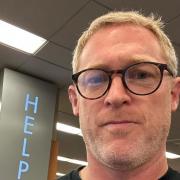Biographies
SPLINTERS.
LESLIE JAMISON
BIOGRAPHY/Jamison, Leslie
Nonfiction, Biographies, Literary Nonfiction
Review by Publisher's Weekly Review Bestseller Jamison (The Empathy Exams) chronicles in this exquisite memoir the dramatic shift her life took following the birth of her daughter and the end of her marriage. After giving birth three weeks before her due date in an emergency C-section, Jamison felt overwhelmingly grateful her daughter survived, even as she struggled with difficulties breastfeeding and other challenges of caring for a newborn. Then the real pain started: just over a year after her daughter was born, Jamison's marriage to her husband, "C," disintegrated as his anger grew more intense, and she began divorce proceedings. Two post-divorce boyfriends--"the tumbleweed" and "the ex-philosopher"--entered the picture, then exited. Throughout, Jamison is brutally honest about the obstacles to balancing creative fulfillment, parenting, dating, and sobriety, utilizing her beguiling command of language to spotlight feelings often obscured in other accounts of motherhood ("Sometimes motherhood tricked me into feeling virtuous because I was always taking care of someone. But it didn't make me virtuous at all. It made me feral and ruthless"). Her soul-searching is sure to inspire readers seeking to find the sweet spot between living for their children and living for themselves. By turns funny, poignant, harrowing, and joyful, this standout personal history isn't easily forgotten.
Molly
Blake Butler
BIOGRAPHY Butler, Blake
Nonfiction, Biographies
"Blake Butler and Molly Brodak instantly connected, fell in love, married and built a life together. Both writers with deep roots in contemporary American literature, their union was an iconic joining of forces between two major and beloved talents. Nearly three years into their marriage, grappling with mental illness and a lifetime of trauma, Molly took her own life. In the days and weeks after Molly's death, Blake discovered shocking secrets she had held back from the world, fundamentally altering his view of their relationship and who she was. A masterpiece of autobiography, Molly is a riveting journey into the darkest and most unthinkable parts of the human heart, emerging with a hard-won, unsurpassedly beautiful understanding that expands the possibilities of language to comprehend and express true love. Unrelentingly clear, honest and concise, Molly approaches the impossible directly, with a total empathy that has no parallel or precedent" --
I must admit that I'm at a bit of a loss for words with this book--I'm not ambivalent, but a little conflicted in how I feel about it. I placed a hold on it before it's publication, based on reviews I read, and in between that time and now, so much has already been said about the book that I know I my reading of it was changed to some degree. I wasn't just reading to learn Molly's story, her life and her life with Blake, her actions, and what one does in the aftermath of the worst situations, but now I was also reading to see if the author needed to be judged in some way, to ascertain if his telling crossed lines or was vindictive, or if parts of the story were even his to tell. I can see why the book has been polarizing for many, and I'll admit that while parts of it were achingly open and full of grief for a love lost, other parts felt more like they were written by someone who has been hurt very much and wants to hurt back. As ever, I would still encourage those who are interested to read it and form your own decision. -Candice
The snow man : a true story
Jonah Winter
CATALOGING /
Science, Biographies
"Discover the true story of a man who lived alone in the mountains with a hobby of measuring snowfall that led to groundbreaking data tracking in climate change studies"--
I am obsessed, I tell you, OBSESSED with this new picture book biography of billy barr, who moved alone to a rustic, isolated cabin in the Rocky Mountains and ended up doing some of the earliest and most groundbreaking tracking related to the heating of the planet when he measured snowfall over time. Jonah Winter has penned more than forty picture book biographies related to environmental, social, and racial justice. Jeannette Winter's illustrations in predominately shades of purple and blue are a phenomenal accompaniment. Check it out! -Anne W
Impossible people : a completely average recovery story
Julia Wertz
362.292092 /Wertz
Graphic Novels, Biographies
"Celebrated cartoonist Julia Wertz chronicles her haphazard attempts at sobriety and the relentlessly challenging, surprisingly funny, and occasionally absurd cycle of addiction and recovery"--
I love graphic memoirs, and Julia Wertz is just too good at drawing her life. Come for an honest graphic memoir about the journey of recovery from a drinking problem, stay for the immature but witty observations on life, beautiful drawings of New York architecture, and the fart jokes. Lots of fart jokes. -Mari
The lost sons of Omaha : two young men in an American tragedy
Joe Sexton
364.1523 /Sexton
Nonfiction, Black Lives Matter, Biographies, History
"On May 30, 2020, in Omaha, Nebraska, amid the protests that rocked our nation after George Floyd's death at the hands of police, thirty-eight-year-old white bar owner and Marine veteran Jake Gardner fatally shot James Scurlock, a twenty-two-year-old Black protester and young father. What followed were two investigations of Scurlock's death, one conducted by the white district attorney Don Kleine, who concluded that Gardner had legally acted in self-defense and released without a trial, and a second grand jury inquiry conducted by African American special prosecutor Fred Franklin that indicted Gardner for manslaughter and demanded he face trial. Days after the indictment, Gardner killed himself with a single bullet to the head. The deaths of both Scurlock and Gardner gave rise to a toxic brew of misinformation, false claims, and competing political agendas. The two men, each with their own complicated backgrounds, were turned into grotesque caricatures. Between the heated debates and diatribes, these twin tragedies amounted to an ugly and heartbreaking reflection of a painfully divided country. Here, Joe Sexton masterfully unpacks the whole twisting, nearly unbelievable chronicle into a meticulously reported and nuanced account of the two deaths, explaining which claims were true and which distorted or simply false. The Lost Sons of Omaha carefully examines some of the most pressing issues facing America today, including our country's dire need for gun control and mental health reform; the dangerous spread of fake news, particularly on social media; and the urgent call to band together in the collective pursuit of truth, fairness, and healing"--
This is really an incredible book--the best long-form journalism I've read in a while. It's not just that the sentences are smooth, direct, and propel the story forward, it's the heart-wrenching story itself. And while technically a true crime narrative, this book goes deep into the histories of two men brought into conflict during a Black Lives Matter protest. Author Joe Sexton masterfully details the little things in these men's lives that made each of them human; a Lion King tattoo for one, war-induced PTSD for another. Both men lost their lives that night, one literally, and the tragedy extends by political factions using them as martyrs for their causes. Read this book to remember to scrutinize every "black and white" story on the internet. Given the divisiveness and tribalism of online political discourse, and the multiple lies we'll all be reading in the run-up to the 2024 election, I consider this a must-read book for the year. -Melody
Life on delay : making peace with a stutter
John (Atlantic senior editor) Hendrickson
616.8554 /Hendrickson
Biographies
"An intimate and revealing memoir of a lifelong struggle to speak"--
This book is for anyone who stutters or who wants to know better the mind of a stutterer. -Tom
A tulip in winter : a story about folk artist Maud Lewis
Kathy Stinson
j759.11 Lewis
Art / Art History, Kids, Biographies
"A celebration of a beloved folk artist, and her artistic expression of joy and beauty. Known for her vibrant and cheerful paintings of landscapes, plants, and animals, Maud Lewis' iconic folk art is celebrated around the world. Despite her beautiful art, she spent much of her life living in poverty with rheumatoid arthritis. In this stunning picture book, author Kathy Stinson and illustrator Lauren Soloy bring Maud's world to life: how she captured in her art what she loved most, while navigating the mobility issues caused by her condition. From bright paintings of the sea and countryside, to the flowers and birds she painted on the walls of the small house she shared with her husband, Maud's work continues to delight and inspire viewers young and old."--
Maud Lewis' lively, colorful paintings were inspired by the countryside around her tiny house in Nova Scotia. Disabled by severe rheumatoid arthritis, and with options further limited by poverty, Lewis lived in a tiny house she decorated by painting flowers all over the stairs, walls, and many of her belongings, along with creating landscapes on scraps of wood and cardboard from the dump. Today, her house can be seen, in its entirety, inside the Art Gallery of Nova Scotia, where it was moved after her death in 1970. -Anne W
The untold story of Larry Itliong : labor rights hero
Cristina Oxtra
j331.88 Itliong
Biographies, History
"You may have read about Cesar Chavez's leadership in organizing the well-known Delano Grape Strike and Boycott of the 1960s. But did you know it began as a strike led by Larry Itliong? He was a Filipino labor organizer who had also been working with grape pickers in California at the time. With key biographical information and related historical events, this Capstone Captivate book will uncover Itliong's story and show how it connects to Chavez's story"--
Take this opportunity to learn about an unsung hero of history and glean more information about where your food comes from! -Anne W
The revolutionary : Samuel Adams
Stacy Schiff
BIOGRAPHY Adams, Samuel
History, Biographies
"Thomas Jefferson asserted that if there was any leader of the Revolution, "Samuel Adams was the man." With high-minded ideals and bare-knuckle tactics, Adams led what could be called the greatest campaign of civil resistance in American history. Stacy Schiff returns Adams to his seat of glory, introducing us to the shrewd and eloquent man who supplied the moral backbone of the American Revolution. He employed every tool available to rally a town, a colony, and eventually a band of colonies behind him, creating the cause that created a country. For his efforts he became the most wanted man in America: When Paul Revere rode to Lexington in 1775, it was to warn Samuel Adams that he was about to be arrested for treason. In The Revolutionary: Samuel Adams, Schiff brings her masterful skills to Adams's improbable life, illuminating his transformation from aimless son of a well-off family to tireless, beguiling radical who mobilized the colonies"--
I really enjoy Schiff’s biographies and histories. She wrote one on Cleopatra and another called "The Witches," which chronicles the New England witchcraft hysteria of the 17th century. Both I recommend highly. Schiff is a great storyteller. She knows how to set the scene, provides interesting context, and then introduces her subject. This time it is founding father and known trouble-maker Samuel Adams. Now sort of a footnote in Revolutionary history, Adams played a huge role in providing unrelenting criticism of the king and parliament, leading to our country’s independence from Britain. Why was his legacy buried? Schiff's take is pretty interesting, especially through our 21st century lens. -Anne M
Number one is walking : my life in the movies and other diversions
Steve Martin
791.43028092 /Martin
Biographies, Humor
"Number One Is Walking is Steve Martin's cinematic legacy-an illustrated memoir of his legendary acting career, with stories from his most popular films and artwork by New Yorker cartoonist Harry Bliss. Steve Martin has never written about his career in the movies before. In Number One Is Walking, he shares anecdotes from the sets of his beloved films-Father of the Bride, Roxanne, The Jerk, Three Amigos, and many more-bringing readers directly into his world. He shares charming tales of antics, moments of inspiration, and exploits with the likes of Paul McCartney, Diane Keaton, Harrison Ford, and Chevy Chase. Martin details his forty years in the movie biz, as well as his stand-up comedy, banjo playing, writing, and cartooning, all with his unparalleled wit. With gorgeously illustrated cartoons and single-panel "diversions" in Steve and Harry's signature style, Number One Is Walking is full of the everyday moments that make up a movie star's life, capturing Steve Martin's singular humor and acclaimed career in film. The perfect gift from the team who brought you the #1 New York Times bestseller A Wealth of Pigeons"--
I am a sucker for graphic novel style memoirs. As a Gen-Y'er, I grew up with the Steve Martin movies from the '80s--Little Shop of Horrors, Roxanne, L.A. Story. L.A. Story remains one of my all-time favorites, and Roxanne got me started on my Cyrano de Bergerac kick in high school. (I made it a point to read every translation and watch every adaptation that I could get my hands on.) This illustrated memoir of his time in Hollywood offers his delightful and comedic behind-the-scenes take on working in the biz. This book is sure to be one of the best celebrity memoirs of 2022. -Melody







To be honest, this book wasn't at the top of my TBR list, but it is now! I was lucky enough to catch Leslie reading and in conversation with Kaveh Akbar at Prairie Lights last night, and within a minute of hearing Ms. Jamison read, I knew that I would be diving into this book ASAP. So much has already been said about her meticulous attention to detail and conjuring scene and emotion with just the right words, and it's all true. For me, though, it was her actual reading of her own words that hooked me so quickly--a cadence somewhere between prose and poetry that illuminated the beauty of the sentences and let their meaning come through at the same time. And if you're worried that a book about being a writer or a divorcée or a mother won't appeal to you if you aren't any of those things, rest assured that there's so much more to the work. As the subtitle says, it's a different kind of love story, and I think there is something in this book that everyone can relate to. -Candice